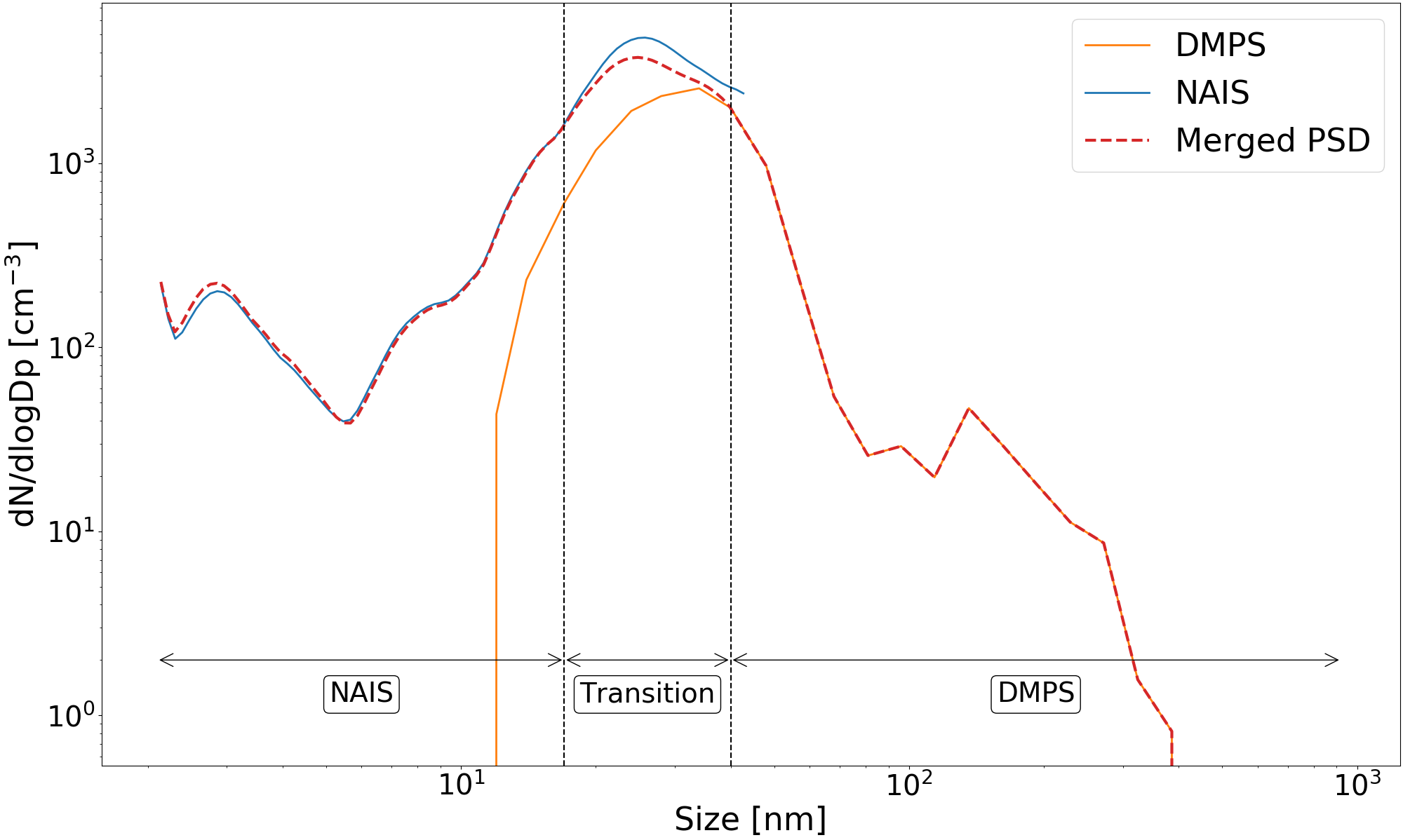Andrea Baccarini, Julia Schmale, Josef Dommen, Linn Karlsson, Paul Zieger
The aerosol size distribution was obtained combining measurements from a neutral and air ion spectrometer (NAIS) with a differential mobility particle sizer (DMPS). Merging particle size distribution (PSD) measurements from different instruments allows to extend the size range of individual instruments and obtain a more complete characterization of the aerosol population.
Aerosols are important for a variety of reasons, one of the most prominent is that a sub-set of the aerosol population can act as cloud condensation nuclei (CCN) influencing cloud formation and the Earth radiative budget. The measurements reported here can be used to investigate aerosol sources and processes.
Measurements were performed on the 4th deck of icebreaker Oden during August and September 2018 along the track of the expedition. The concentration is reported as dN/dlog(Dp) per cubic centimeter with a 3 minutes time resolution.
Download data
Citation
Andrea Baccarini, Julia Schmale, Josef Dommen, Linn Karlsson, Paul Zieger (2020) Size distribution of aerosol particles between 2.5 and 920 nm measured during the Arctic Ocean 2018 expedition. Dataset version 1. Bolin Centre Database. https://doi.org/10.17043/oden-ao-2018-aerosol-merged-psd-1
References
Baccarini A, Karlsson L, Dommen J, Duplessis P, Vüllers J, Brooks IM, Saiz-Lopez A, Salter M, Tjernström M, Baltensperger U, Zieger P, Schmale J (2020) Frequent new particle formation over the high Arctic pack ice by enhanced iodine emissions. Nature Communications 11:4924. https://doi.org/10.1038/s41467-020-18551-0
Data description
We produced the merged PSD by averaging the NAIS and DMPS data where their size measurement range overlaps (20 - 40 nm) and combined these data directly with the NAIS measurements below 20 nm and with the DMPS above 40 nm. For the averaging, we used a weighted average with the NAIS and the DMPS data weighting more at smaller and larger sizes respectively (weights were linearly distributed between 0 and 1). Measurements were corrected for transmission losses and cleaned from exhaust influence before the merging procedure.
The datetime is reported as UTC in the format yyyy-mm-dd HH:MM:SS.
Data are reported as dN/dlog(Dp), where dN is the particle number concentration per cubic centimeter per measured size bin, normalized over the logarithm of the bin width. The bin width is defined as the distance between two diameters.
For those periods when the NAIS was not measuring or did not provide reliable data the merged PSD was set equal to the DMPS only. In these cases, the columns in the data files corresponding to the NAIS diameter bins where left empty.
Comments
The ship track with latitude and longitude information can be found in the Navigation, meteorological and surface seawater data from the Arctic Ocean 2018 expedition data set.
The original data sets for the merged PSD product can be found in the Aerosol particle number size distribution data collected during the Arctic Ocean 2018 expedition and Size distribution of neutral and charged particles smaller than 42 nm collected during the Arctic Ocean 2018 expedition data sets.
The data creator ORCID are the following:
Data were collected during the Arctic Ocean 2018 expedition on board the Swedish icebreaker (I/B) Oden, which was organized by the Swedish Polar Research Secretariat. The observations were part of the project ‘Aerosol-cloud interactions in the High Arctic’ (PI Paul Zieger, Department of Environmental Science, Stockholm University; see MOCCHA project website with updates).
Image caption
The figure shows an example of a merged particle size distribution (PSD), the original PSDs measured with the NAIS and the DMPS are reported in the background. The vertical dashed lines indicate the size range interval where the averaging between the two PSDs was performed.
GCMD science keywords
Earth science > Atmosphere
GCMD location
Ocean > Arctic Ocean
Project
Arctic Ocean 2018. This work was supported by the Swiss National Science Foundation (grant no. 200021_169090), the Swiss Polar Institute, the BNP Paribas Swiss Foundation (Polar Access Fund 2018), the Knut-and-Alice-Wallenberg Foundation within the ACAS project (Arctic Climate Across Scales, project no. 2016.0024), the Bolin Centre for Climate Research (RA2), the Swedish Research Council (project no. 2018-05045 and project no. 2016-05100).
Publisher
Bolin Centre Database
DOI
10.17043/oden-ao-2018-aerosol-merged-psd-1
Published
2020-09-23 12:00:28
